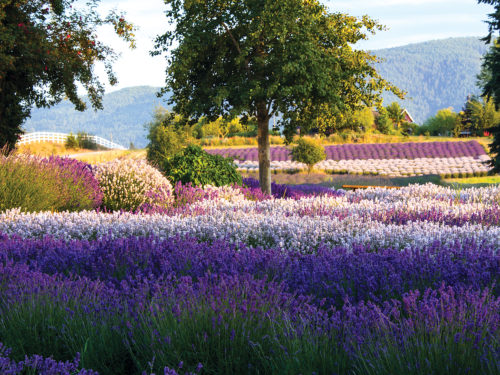[vc_row][vc_column][vc_column_text]

Paul Jendrucko shares everything you wanted to know about growing lavender in your home garden.
Paul Jendrucko, or “Dr. Lavender,” of Sequim, Washington, is a well-known resource for all things lavender. We consulted him to learn the scoop for growing this heavenly-scented plant. He shares both need-to-know facts and practical tips for tending your own lavender garden. Here’s his prescription:

Portrait Photo Courtesy of Mary & Paul Jendrucko
1) Lavender is described as a woody or bushy perennial, which means it lives throughout the four seasons and exhibits a dormancy stage in the winter and a reproductive (flowering) stage in the summer.
2) Lavender requires no fertilizers, pesticides, or chemicals to maintain its vigor, and no insects or animals prefer the plant as a food source.
3) Be both inquisitive and cautious when selecting over-the-counter and mass-propagated varieties produced in warmer climates. Your selection of lavender should be mainly based on what you observe thriving in your growing region and on what you learn from the all-important label on the plant container.
4) Most plants peak at about 2–3 feet in height and at least that measurement in width when in full bloom. It may take two or three growing seasons to reach a mature height.
5) Suitable planting conditions exist when the soil drains and does not puddle and remain sticky. The weather should be leaning toward a trend favoring cool and moderate temperatures. Ideally, soil temperature should be above 50°F.

Bundles of freshly picked lavender in Sequim, Washington | Photo © Georgianna Lane
6) During the first growing season, the lavender plant is focusing on building a good root system and some top foliage instead of on reproduction. The plant will produce several flower spikes to show off its beauty. Snip growth off at the base of the spike (or stem) where it leads to a pair of leaves. During the following seasons, the plant will noticeably increase in size and produce bountiful blooms.
7) Promote sun and good air circulation to produce robust blooms and to maintain the health of the plant. Provide lavender with five or more hours of sunlight each day during the growing season, and don’t overwater. In general, lavender does not require regular watering and can survive on rainfall alone.
8) Place lavender outside the perimeter of vegetable gardens to attract and invite pollinators.
9) Prune in mid- to late October and perform the “Halloween haircut.” The weather is still pleasant, the soil is firm, and holiday activities are a month away. When pruned, your plant should resemble a bowl or sleeping porcupine. Always prune so that 2–3 inches of green growth remain on the plant. Despite what you may have heard or seen, lavender does not respond favorably to heavy pruning deep into the brown woody growth.
10) Harvest lavender for display in a vase or floral arrangement when the buds have swollen to a deep blue or purple color and several of the trumpet flowers have emerged. Harvesting can occur as the flowers continue to blossom. It is also best to harvest when no more than 25%–30% of the flowers have blossomed.
More Lavender!
View this colorful, fragrant perennial for miles in Sequim, Washington, where both a temperate climate and a cluster of small farmers encourage it to flourish.
[/vc_column_text][/vc_column][/vc_row][vc_row][vc_column][/vc_column][/vc_row]




